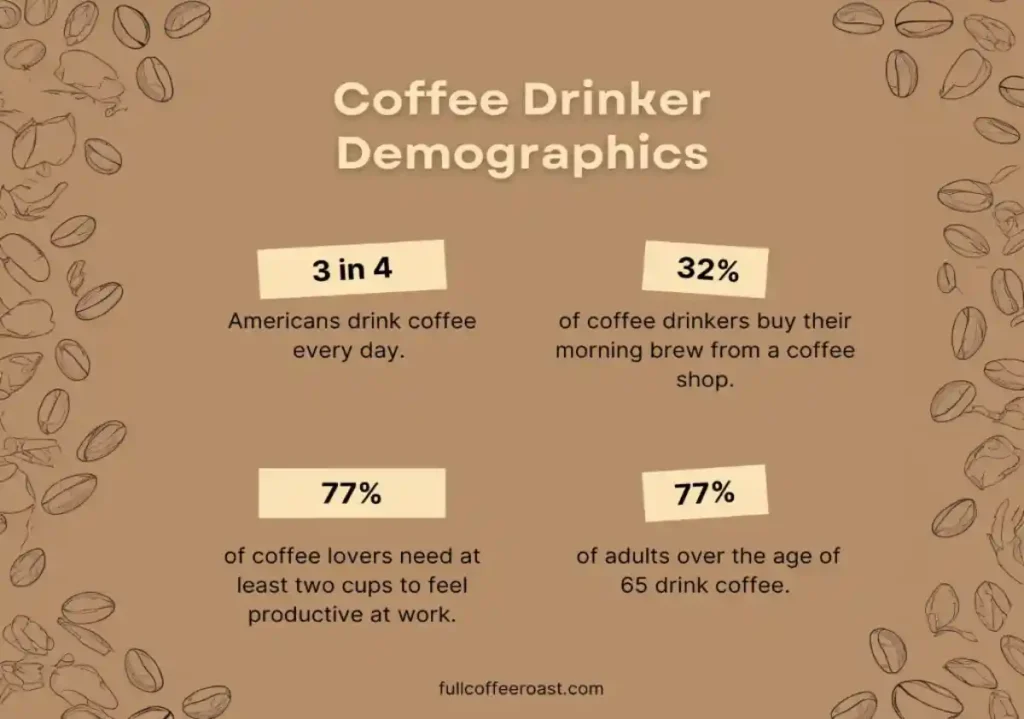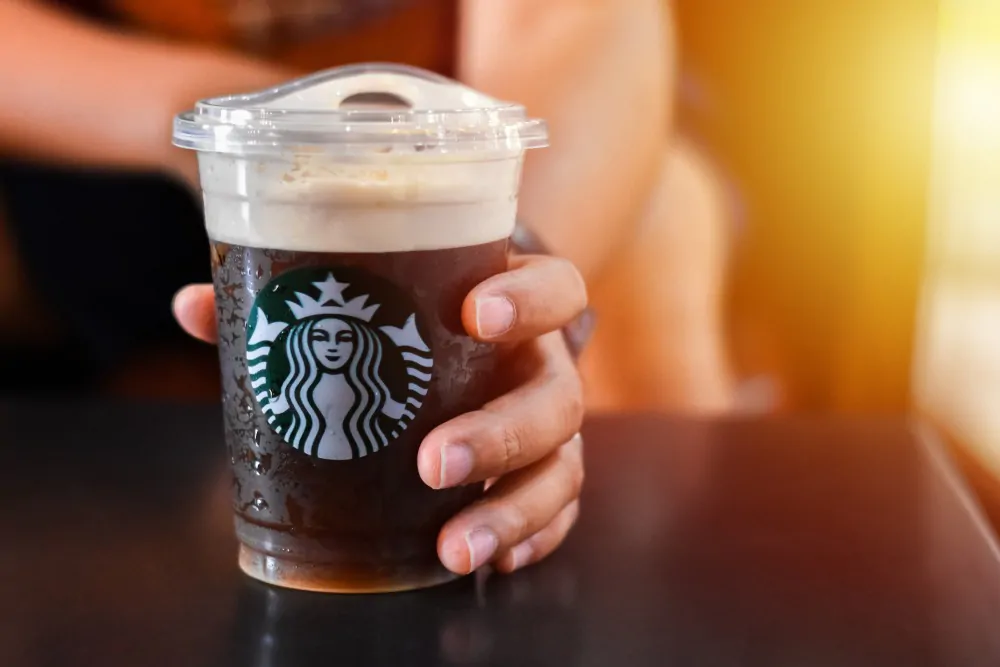There is no shortage of coffee lovers, but how many are there? We’ve gathered exciting coffee drinker demographics to uncover the habits of coffee lovers.

As of 2023, the coffee industry generated a whopping $111bn in revenue worldwide. The coffee market isn’t slowing down either, as the industry is expected to grow by 4.61% per year. With coffee consumption being so high, you might start to wonder, who drinks the most coffee, and what are the drinks of choice?
We’ve compiled all the data so you can wow your friends with a quick fact over a cup of Joe. After all, almost 90% of American coffee drinkers see themselves as coffee addicts, so they’re bound to be impressed. Learn more in our guide on the types of coffee.
Which Countries Drink The Most Coffee Per Capita?
There are around one billion coffee drinkers worldwide, but the data proves that some nations drink more coffee than others.
According to Wise Voter, the United States can’t get enough java, consuming 26,651,000 bags of coffee per year. Brazil came in second, drinking 22,000,000 bags. Germany was the third biggest coffee-drinking country, with 8,670,000 bags consumed.
Also in the top ten were:
- Japan: 7,355,000 bags
- France: 6,192,000 bags
- Italy: 5,469,000 bags
- Indonesia: 4,806,000 bags
- Russia: 4,631,000 bags
- Canada: 3,929,000 bags
- Ethiopia: 3,781,000 bags
The countries that drank the least coffee were Slovenia, Estonia, Cyprus, Latvia, and Malta, which consumed the lowest amount of coffee with 28,000 bags. However, keep in mind that population figures may explain the lower numbers of coffee drinkers. For example, the population of Malta is only 518,000.
We can learn more by determining how much coffee the average person drinks. According to Statista, three in four Americans drink coffee every day. Eighty percent of those daily coffee drinkers consumed two or more servings if they were at home; more than half of them had three cups or more per day.
The population of the United States is more than 340,000,000, while Germany is home to just over 83,000,000 people. Yet, German coffee drinkers consume an average of four cups a day, so technically, we could argue that while U.S. coffee consumption is high, Germany is a bigger coffee-drinking country.
The coffee drinking habits can even vary per region. In Brazil, participants from Mato Grosso consumed 7.1 cups of coffee per day, but those in São Paulo had 4.4 cups, and residents in Sergipe drank 4.1 cups.
What Age Group Drinks The Most Coffee?
Coffee drinkers also have different habits based on age. Most coffee drinkers are older adults.
According to a Statista survey, 77% of participants aged 65 and older drank coffee, followed by 76% of 45 to 64-year-olds. Coffee is still popular among the younger generation, with 68% of 18 to 29-year-olds drinking it.
Interestingly, older coffee drinkers are more interested in regular coffee drinks, but younger coffee drinkers, like Millennials and Gen Z, prefer cold coffee. According to Drink Insights Network, 28% of participants between the ages of 18 and 34 were interested in or actively buying cold brew, compared to 17% of subjects who were 35 or older.
Although this particular study took place in 2017, more recent data suggests the trend isn’t going anywhere. In 2021, it was reported that around 94% of coffee drinkers over 56 drank hot coffee, while 40% of Gen Z liked cold brew.
Coffee Consumption Statistics: Coffee Shops Vs. Home Brewing

While we love stopping by a coffee shop every now and then, it quickly starts to eat into your wallet. For this reason, most people prefer to make their coffee at home.
Only 32% of coffee lovers buy their morning fix from a café one to three days per week, according to Dive Research. While 68% of coffee drinkers in the U.S. brew coffee at home every day.
Of those who buy their java from a coffee shop, 39% of participants said Starbucks was their preferred chain, while 30% liked Dunkin’ more. McCafé and Peet’s were still fairly popular, too.
As for their drinks of choice, the most popular order was flavored lattes at 38%, followed by flat whites at 32%, and filter coffee coming in at 31%.
Cold brew was still fairly popular, with 30% of respondents selecting it as their drink of choice. A cappuccino or Piccolo latte was a little less popular at 29%, leaving 20% of people ordering Americanos, black coffee, or long blacks and 19% choosing espresso.
While the average American coffee lover may prefer Joe from a drip coffee maker or single-serve pods, espresso is more popular in Europe.
Specialty coffee is growing in popularity, too. Also known as gourmet coffee, these are simply coffees that are extremely high quality. In 2017, the National Coffee Association found that 59% of coffee consumed daily was specialty coffee.
This was a huge leap, as only 46% of respondents drank specialty coffee in 2012.
The hype around gourmet coffee isn’t going anywhere, either. In July 2021, the NCA and the Speciality Coffee Association found that 62% of all coffee consumed in the past day when taking the survey was specialty Java, while 56% of participants reported drinking it in the past day when taking the same survey earlier that year in January.
Although specialty coffee can be on the pricey side, it’s popular among home baristas who think it is cheaper to brew high-quality coffee at home rather than go to a coffee shop.
What Is The Most Popular Home Brewing Method?
According to the same Dive Research study, the most popular brewing methods were drip coffee, which 31% of participants liked, and pod brewers, specifically K-cups, which were also favored by another 31% of coffee drinkers.
Only 6% of people enjoyed instant coffee, compared to 23% who liked brewing with ground coffee. Only 4% liked French press coffee. Although once trendy, only 1% of people actually made whipped coffee, and other methods accounted for the remaining 4% of participants.
You might also be interested in our dalgona coffee explainer.
Reasons For Drinking Coffee
It should go without saying, but one of the main reasons people drink coffee beverages is to help them wake up in the morning.
One survey found that 77% of coffee lovers need at least two cups of Joe in order to feel productive during the work week, with 24% of respondents admitting they drank the most coffee on Mondays. At least 60% drank coffee during work to boost their mood too.
Seventy-seven percent of coffee drinkers need two or more cups of coffee to feel productive on a workday, with nearly a quarter (24%) noting Mondays were the day of the week they needed the most coffee.
One of the other reasons people drink coffee is because of the potential health benefits. Caffeine can increase mental alertness and boost adrenaline levels, which is why it’s a popular pre-workout drink.
Coffee is also a source of antioxidants. These are compounds that tackle free radical damage, which can contribute to premature aging and the risk of developing ailments like heart disease.
Other common reasons people drink coffee are because they enjoy the taste and aroma, drinking coffee offers comfort and pleasure, out of habit, and as a way to socialize with others.
Where Does Coffee Come From?

Most coffee is found in the equatorial belt due to the warm climate, but it’s known as the bean belt in the Java world.
Coffee is believed to have originated in Ethiopia, but now there are 50 coffee-producing countries worldwide. The biggest coffee-growing region is Brazil by far. The nation produces a staggering 5,714,381,000 pounds of coffee per year.
Following Brazil, Vietnam is the second largest coffee-producing country, accounting for 637,627,000 pounds of Joe, while Colombia produces 1,785,744,000 pounds.
Coffee production is also high in the following countries:
- Indonesia: 1,455,050,000 pounds
- Ethiopia: 846,575,000 pounds
- Honduras: 767,208,000 pounds
- India: 767,208,000 pounds
- Uganda: 634,931,000 pounds
- Mexico: 515,881,000 pounds
- Guatemala: 449,743,000 pounds
There are several different types of coffee, but the main two are Arabica and Robusta coffee. Due to the less favorable flavors, only 30% of the world’s coffee is made from Robusta beans, while Arabica accounts for the remaining 70%. Learn more in our guide on the types of coffee beans.

